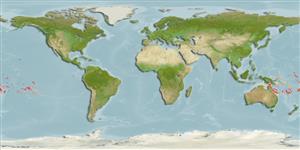Classification / Names
Κοινά ονόματα | Συνώνυμα | Catalog of Fishes(Γένος, Είδη) | ITIS | CoL | WoRMS | Cloffa
>
Blenniiformes (Blennies) >
Blenniidae (Combtooth blennies) > Salariinae
Etymology: Cirripectes: Latin, cirrus = curl fringe + Greek, pektos, -e, -on = made of several parts solidly united (Ref. 45335); jenningsi: Named for Mr. Jennings of Swains Island.
Eponymy: Alexander Hutchinson Jennings (ca: 1896–1958) was the grandson of Eli Hutchinson Jennings who took possession of Swains Island, American Samoa (1856). [...] (Ref. 128868), visit book page.
More on author: Schultz.
Environment: milieu / climate zone / εύρος βάθους / distribution range
Οικολογία
Θαλασσινό(ά) βενθικό(ς); εύρος βάθους 0 - 10 m. Tropical; 5°N - 25°S
Pacific Ocean: Gilbert Islands to the Tuamoto Islands.
Length at first maturity / Μέγεθος / Βάρος / Age
Γεννητική Ωρίμανση: Lm ?, range 4 - ? cm
Max length : 7.6 cm SL αρσενικό/απροσδιόριστο; (Ref. 529)
Ραχιαίες άκανθες (συνολικά) : 12 - 13; Μαλακές ραχιαίες ακτίνες (συνολικά) : 15 - 16; Εδρικές άκανθες: 2; Μαλακές εδρικές ακτίνες: 15 - 17; Σπόνδυλοι: 31 - 32. Diagnosis: Dorsal fin XII, 15, membrane attached to caudal fin, with deep notch above last spine, first spine almost same or slightly higher than second; anal fin II, 16; pectoral rays 15; pelvic fin I, 4; caudal fin procurrent rays 10-14. Vertebrae 10 + 21. LL, without scales and scalelike flaps; LL tubes 2-11 (usually 5-9), canal ends below 15th dorsal ray to caudal-fin base. Upper lip crenulae 41-47. Gill rakers 19-24. Cephalic sensory pore complex. Cirri, supraorbital 2-4, nasal 8-19; nuchal 34-44, row uninterrupted, without nuchal flap, cirri connected at their bases by a membranous ridge. Adults and juveniles anterior body light rose with black spots and 2 broad bars, posteriorly dark purple or blue with white spots, cirri pale. Ophioblennius overall cream with small dark brown spot on posterior of lower lip (in alcohol) (Ref. 529).
Body shape (shape guide): fusiform / normal; Cross section: oval.
Facultative air-breathing in the genus (Ref. 126274); Adults inhabit shallow coral reefs (Ref. 529). Oviparous. Eggs are demersal and adhesive (Ref. 205), and are attached to the substrate via a filamentous, adhesive pad or pedestal (Ref. 94114). Larvae are planktonic, often found in shallow, coastal waters (Ref. 94114).
Oviparous, distinct pairing (Ref. 205). Urogenital orifice of male genital papilla located basally behind a single slender filament on a fleshy swelling behind anus; testes bulbous with length equal to its width (Ref. 529).
Williams, J.T., 1988. Revision and phylogenetic relationships of the blenniid fish genus Cirripectes. Indo-Pac. Fish. (17):78 p. (Ref. 529)
IUCN Red List Status (Ref. 130435: Version 2025-1)
Threat to humans
Harmless
Human uses
αλιεία: χωρίς ενδιαφέρον
Εργαλεία
Special reports
Download XML
Διαδικτυακές πηγές
Estimates based on models
Preferred temperature (Αναφ.
123201): 25.2 - 29.1, mean 27.4 °C (based on 304 cells).
Phylogenetic diversity index (Αναφ.
82804): PD
50 = 0.5000 [Uniqueness, from 0.5 = low to 2.0 = high].
Bayesian length-weight: a=0.01047 (0.00461 - 0.02381), b=2.98 (2.79 - 3.17), in cm total length, based on LWR estimates for this (Sub)family-body shape (Ref.
93245).
Τροφικό Επίπεδο (Αναφ.
69278): 2.0 ±0.00 se; based on food items.
Ελαστικότητα (Αναφ.
120179): Υψηλό, ελάχιστος χρόνος για διπλασιασμό πληθυσμού < 15 μήνες (Preliminary K or Fecundity.).
Fishing Vulnerability (Ref.
59153): Low vulnerability (10 of 100).
🛈
